Conservation in action
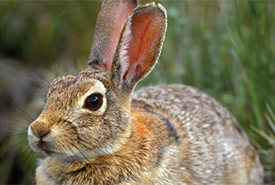
Nuttall's cottontail (Photo by Robert McCaw)
As you’ve read in the previous pages, you have helped secure 540 projects, conserving an additional 115,000 square kilometres of protected areas. Through the Landmark Campaign, you have protected habitat for more than 130 species at risk. Ten of these species are more threatened than the giant panda, based on their global status.
Wildlife at risk
Sprague’s pipit
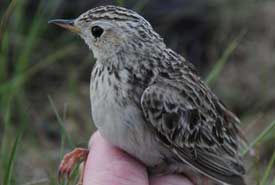
Sprague's pipit (Photo by Steve Zack)
Conservation status: Threatened
NCC natural areas where this species is found: Asquith Complex, SK
Sprague’s pipit breeds from southern and central Alberta, to southwestern Manitoba and south to southern Montana, northern South Dakota and northwestern Minnesota. It spends winters in the southwestern United States and northern Mexico. The species is considered a native grassland specialist and prefers to nest in intact prairies with moderate levels of grazing. Like many grassland birds, its numbers have been rapidly declining.
Nuttall's cottontail
Conservation status: Special concern
NCC natural areas where this species is found: South Okanagan-Similkameen, BC
The Canadian range of Nuttall’s cottontail (nuttallii subspecies) is restricted to the Okanagan Valley of southcentral BC. Also known as the mountain cottontail, it is Canada’s smallest member of the rabbit and hare family, weighing just over 450 grams. It lives in open grassland, sagebrush and ponderosa pine ecosystems. There are only a few thousand left in BC, and they are primarily threatened by habitat loss. Its cousin, the grangeri subspecies, is more widespread and can be found in Alberta and Saskatchewan. NCC has protected habitat for Nuttall’s cottontail on the Sage and Sparrow Conservation Area. This property also protects habitat for over 60 other species at risk.
Maritime ringlet*
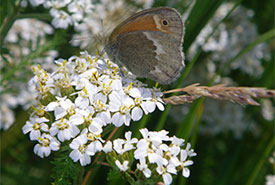
Maritime ringlet (Photo by NCC)
Conservation status: Endangered
NCC natural areas where this species is found: Barachois de la rivière Nouvelle, QC
Maritime ringlet is one of the most endangered butterflies in Canada. The global range of this small butterfly is restricted to 10 scattered locations along coastal salt marshes in northern New Brunswick and the southern coast of the Gaspé Peninsula in Quebec, around the Baie des Chaleurs. This species’ survival relies on salt marsh habitat with suitable plants. Threats include rising sea levels and increasing frequency of storm surges as a result of climate change.
*This species can be found only in Canada and nowhere else in the world. Visit leaveyourlandmark.ca for more information.
Conservation Volunteers
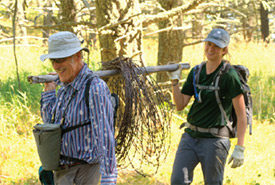
Conservation Volunteers transporting barbed wire (Photo by David Thomas)
Thank you to all of our 18,000 Conservation Volunteers who rolled up their sleeves, directly caring for nature throughout the Landmark Campaign. NCC’s Conservation Volunteers program engages people of all ages in the protection of our country’s species and natural habitats, coast to coast. Thank you to each and every volunteer who joined us in the field to contribute to conservation! Throughout the Landmark Campaign, Conservation Volunteers:
- Contributed over 37,000 hours of their time.
- That’s equivalent to more than 1,500 full days of work!
- Participated in 1,565 Conservation Volunteers events.
- Completed essential tasks on properties across Canada, such as restoring habitat, stewarding the land and monitoring species.
Want to know how you can connect with nature? Visit conservationvolunteers.ca.
Natural Areas Conservation Program
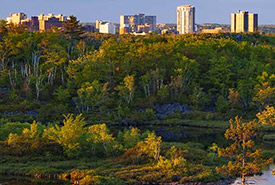
Halifax skyline viewed from the future Halifax Wilderness Park (Photo by Irwin Barrett)
The completion of NCC’s successful Landmark Campaign was made possible by generous contributions from so many individuals and organizations, including governments across the country. The Government of Canada is the largest single contributor to the campaign. Through the Natural Areas Conservation Program and Natural Heritage Conservation Program (NHCP), the federal government contributed $160 million to the campaign. These funds were matched by generous donors to create lasting conservation success. The current iteration of the partnership, the NHCP, is administered by the Nature Conservancy of Canada and made possible by a $100-million investment from the Government of Canada, as part of the Nature Legacy initiative announced in Budget 2018. Thanks to the NHCP, NCC will be able to help protect the lands and waters that sustain our local communities. These conservation projects will also support Canada’s commitment to protect 30 per cent of our lands and waters by 2030.
This story originally appeared in the Winter 2021 issue of the Nature Conservancy of Canada Magazine. To learn more about how you can receive the magazine, click here.




